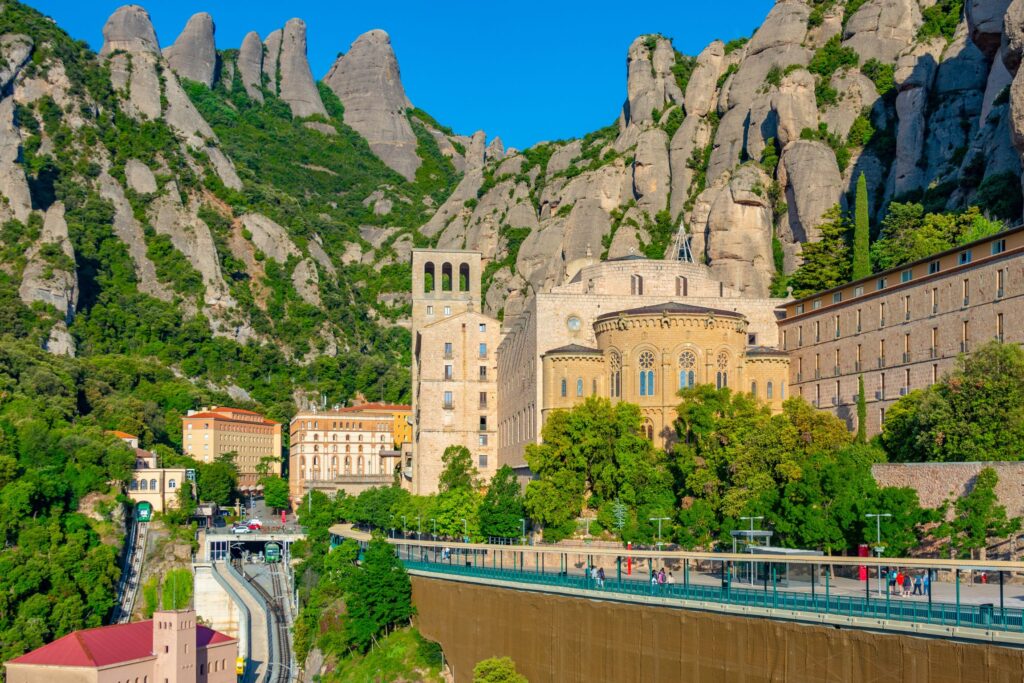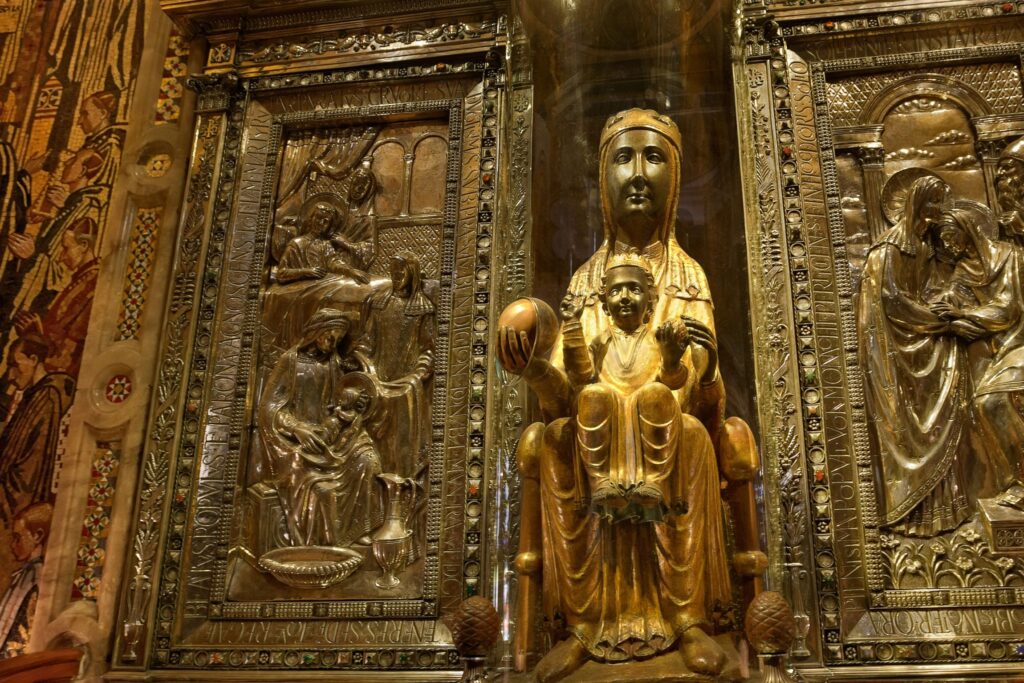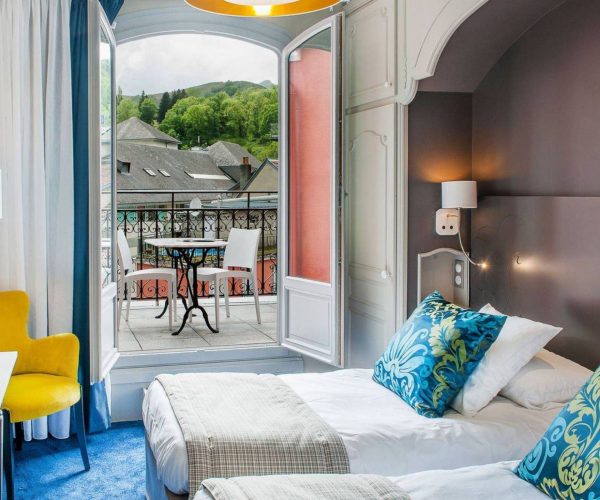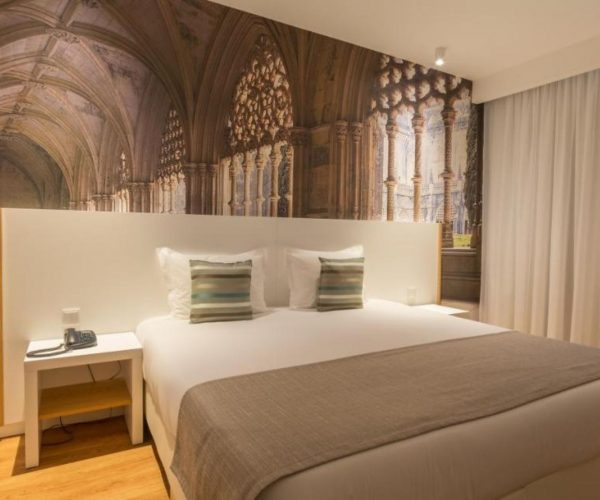Mount Montserrat, Catalonia’s Sacred Mountain, is distinguished for its iconic needle-shaped peaks and rocky formations, sculpted over millions of years by natural erosion; and creating a landscape unlike any other. But Montserrat is more than just a mountain, it is a place where natural beauty and spiritual heritage come together.
This Benedictine monk mountain is home to the Santa María de Montserrat Monastery, a revered sanctuary for pilgrims and travelers alike. The monastery houses an ancient wooden statue of the Virgin and Child, believed to have been carved by St. Luke and brought to Spain by St. Peter. Hidden in a cave during the Moorish occupation and rediscovered in 880, this sacred statue has inspired awe and devotion for centuries, with many attributing miracles to the Virgin Mary’s intercession.
Join us as we explore the rich history and serene tranquility of this remarkable monastery and its natural park, a setting of wonderful and dramatic beauty.

ORIGINS OF THE MONASTERY
The historical origins and first documentation of the sanctuary of the Virgin Mary of Montserrat trace back to the year 888 when Count Guifré el Pelós gave the hermitage of Santa Maria de Montserrat to the Monastery of Ripoll. According to legend the image of the Mother of God had been found in a cave in the mountain in 880.
By 1025, Oliba, Abbot of Ripoll and Bishop of Vic, had founded a new monastery at the hermitage of Santa Maria, which soon gained attention and attracted pilgrims and visitors who spread stories of miraculous acts attributed to the Virgin.
The year 1409 marked another turning point in Montserrat’s history, when the monastery became an independent abbey order; and during the period from 1493 to 1835, it underwent significant expansion and reform as part of the Valladolid Congregation.
The 17th and 18th centuries solidified Montserrat as a major cultural centre, including the Montserrat Music School, which produced some of the most important composers of the time.
The monastery went through a period of destruction and abandonment during The French War (1808-1811), but by 1844, the restoration of the monastery began. In 1881, the festivities for the Coronation of the image of Our Lady of Montserrat happened and Pope Leo XIII declared Our Lady of Montserrat the Patron Saint of Catalonia.
During the Spanish Civil War, the monastery suffered again a period of abandonment, but the Government of Catalonia resisted. Despite the regime’s ban on Catalan culture, the monastery continued to hold masses in Catalan, preserving the language and identity of the people. Today, Montserrat is more than a religious site; it has become a profound symbol of Catalan identity and the enduring struggle against oppression. More than a thousand years after its founding, Montserrat Monastery has been modernised and it continues to be a destination for pilgrims.
BLACK MADONNA, MORENETA
In the monastery’s Basilica lies the image of Our Lady of Montserrat, known as the Moreneta, or Black Madonna, a Romanesque-style carving of the 12th century, distinguished by the dark colour of her skin, a feature that adds to her enigmatic and revered presence. It owes it dark appearance the type of wood used and the natural aging process.
Declared Patron Saint of Catalonia by Pope Leo XIII in 1881, the statue was enthroned in a silver altarpiece in 1947 and located in the upper section of the basilica apse. It imitates the image of of Our Lady Majesty, and She is depicted in a frontal posture with the Baby Jesus on her lap, both adorned with crowns. Our Lady is portrayed holding the globe in Her right hand symbolising the cosmos and resting Her left hand on the Child’s shoulder indicating that is Her Son. The Child extends His right hand in a gesture of blessing, and His left hand holds a pinecone, a symbol of everlasting life and fertility.
La Moreneta attracts pilgrims and visitors from all corners of the world, who come to Montserrat to worship it.

HOLY GROTTO
Santa Cova, refer as “the Holy Grotto”, is an important place of pilgrimage when visiting Montserrat Monastery as it is believed the image of the Virgin Mary appeared here inside a cave.
According to legend the history of Santa Cova, found in a text dating back to 1239, stating that in 880 a group of shepherd children saw a bright light falling from the sky in the Montserrat mountains, followed by the singing of angels. The same vision was witnessed by their parents and the rector from the town of Olesa. As the vision occurred in a cave in Montserrat mountain, some religious elders of the community explored the cave, and they found an image of the Virgin Mary. Since then, the cave has become a venerated sanctuary and a place of pilgrimage.
In Santa Cova, pilgrims will find “the Chapel of the Holy Grotto”, dating back to the 17th century and the beginning of the 18th. Here, visitors can find a reproduction of the Holy Image ( reproduction of the original image from the Basilica ).
MUSEUM
The Museu de Montserrat, is one of the most beautiful art galleries in Spain. Visitors can admire masterpieces by renowned artists such as Caravaggio, El Greco, Degas, Monet, Ramon Casas, Santiago Rusiñol, Picasso and Dalí, as well as an architectural collection with pieces from Egypt and Mesopotamia.
In 1911, Benedictine monk Bonaventura Ubach transformed a small room inside the monastery into a gallery exhibiting pieces of ancient art, known as the Museu Bíblic. As the collection expanded, it found a new home beneath the monastery square. Today, more than 1,300 works by great masters are on display, including important collections of Catalan painting of the 19th and 20th centuries.
MONTSERRAT NATURE PARK
Surrounding the monastery, visitors can explore and admire the Natural Park of Montserrat. In 1987, Montserrat was declared a natural park, offering visitors a beautiful environment to immerse themselves in nature and spirituality.
The journey to the peaks of Montserrat begins with a 300-meter ascent from the monastery, where a cogwheel train runs almost to the summit. Visitors can embark on great hiking experiences through the various trails of the park, leading from the mountain station of the funicular to the abandoned hermitages. Its prominent peak, known as Sant Jeroni, towers at an impressive 1236 meters above sea level, is one of Montserrat most famous trails, offering breathtaking views of Catalonia.
Exploring Montserrat is not just a physical journey but a spiritual experience, where the harmonious blend of nature and history creates a lasting impression on all who venture to this remarkable destination.
You can find additional details and information about Montserrat Monastery at: MONTSERRATVISITA.COM or BARCELONA TURISME
At Joe Walsh Tours we organize Choir Tour for groups to Costa Brava and Barcelona with visits and performs in Montserrat Monastery.
For more information about our upcoming pilgrimages or to organise a group trip contact the Joe Walsh Tours Pilgrimage travel experts.
Contact Us



